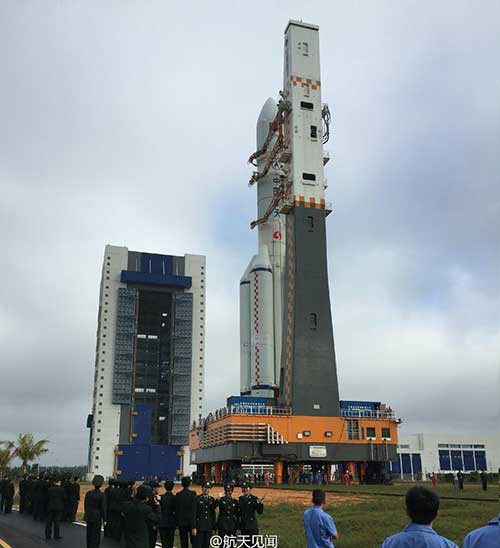


China has made a major breakthrough in key technologies for its new generation heavy-lift launch vehicle, Long March-5 (LM-5), and plans to do a test launch later this year, according to China National Space Administration on Tuesday.
The vehicles have a maximum payload capacity of 25,000 kilograms for low Earth orbit and 14,000 kilograms for geostationary transfer orbit—twice that of the most advanced rockets currently in service, said Li Guoping, spokesperson of China National Space Administration.
The Long March-5 will use a non-toxic and pollution-free propellant, Li said.

In addition, the new generation Long March-7 will make its debut this year. And new spacecraft for major projects, including manned space missions and the Beidou navigation system, will also be launched this year.
Meanwhile, new satellites will be launched, such as Feng Yun IV, a second-generation Meteosat geostationary meteorological satellite, which is the most advanced of its kind.
The Hard X-ray Modulation Telescope (HXMT), a new exploration satellite, will also be launched this year. It will perform hard X-ray surveys of the sky, in which about 1,000 new hard X-ray sources will be discovered. Additionally, it will make sensitive observations of important cosmic X-ray sources, including black holes and neutron stars.
Day|Week

 Finding sexiest underwear supermodels
Finding sexiest underwear supermodels Top 10 ancient pagodas in China
Top 10 ancient pagodas in China Chinese version of Victoria's Secret Show held in Hunan
Chinese version of Victoria's Secret Show held in Hunan Can you find out the sniper hiding in camouflage?
Can you find out the sniper hiding in camouflage? Spectacular rockets launch scenes
Spectacular rockets launch scenes Spectacular aerial photos of the Three Gorges
Spectacular aerial photos of the Three Gorges Admit it! That is a High-way built by China
Admit it! That is a High-way built by China Photos of Beijing Film Academy student hit the Internet
Photos of Beijing Film Academy student hit the Internet Spectacular aerial photos of the Three Gorges
Spectacular aerial photos of the Three Gorges New balls please! Polish sports stars strip off for risqué calendar
New balls please! Polish sports stars strip off for risqué calendar